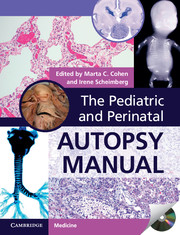Book contents
- Frontmatter
- Contents
- List of contributors
- Foreword
- Preface
- Acknowledgments
- 1 Perinatal autopsy, techniques, and classifications
- 2 Placental examination
- 3 The fetus less than 15 weeks gestation
- 4 Stillbirth and intrauterine growth restriction
- 5 Hydrops fetalis
- 6 Pathology of twinning and higher multiple pregnancy
- 7 Is this a syndrome? Patterns in genetic conditions
- 8 The metabolic disease autopsy
- 9 The abnormal heart
- 10 Central nervous system
- 11 Significant congenital abnormalities of the respiratory, digestive, and renal systems
- 12 Skeletal dysplasias
- 13 Congenital tumors
- 14 Complications of prematurity
- 15 Intrapartum and neonatal death
- 16 Sudden unexpected death in infancy
- 17 Infections and malnutrition
- 18 Role of MRI and radiology in post mortems
- 19 The forensic post mortem
- 20 Appendix tables
- Index
- References
13 - Congenital tumors
Published online by Cambridge University Press: 05 September 2014
- Frontmatter
- Contents
- List of contributors
- Foreword
- Preface
- Acknowledgments
- 1 Perinatal autopsy, techniques, and classifications
- 2 Placental examination
- 3 The fetus less than 15 weeks gestation
- 4 Stillbirth and intrauterine growth restriction
- 5 Hydrops fetalis
- 6 Pathology of twinning and higher multiple pregnancy
- 7 Is this a syndrome? Patterns in genetic conditions
- 8 The metabolic disease autopsy
- 9 The abnormal heart
- 10 Central nervous system
- 11 Significant congenital abnormalities of the respiratory, digestive, and renal systems
- 12 Skeletal dysplasias
- 13 Congenital tumors
- 14 Complications of prematurity
- 15 Intrapartum and neonatal death
- 16 Sudden unexpected death in infancy
- 17 Infections and malnutrition
- 18 Role of MRI and radiology in post mortems
- 19 The forensic post mortem
- 20 Appendix tables
- Index
- References
Summary
Introduction
Tumors detected at birth or in the perinatal period are relatively uncommon; they are even more uncommon as a cause of death resulting in post mortem study. Current therapeutic protocols have improved survival for most perinatal tumors with advanced surgical options that are far advanced and intensive care support that has resulted in many of the newborns surviving to much older ages and even being completely freed of these tumors. Many of the congenital tumors are detected later in the first year of life and hence may not all come into the purview of perinatal (antenatal and neonatal) tumors [1–4]. The ones most likely to come to attention at birth or in utero are large tumors that may interfere with the birth of the child, or those that cause intrauterine distress or fetal hydrops. A majority of the tumors detected in the perinatal/neonatal period are benign tumors; some are even considered to be hamartomas rather than malignant neoplasms (Table 13.1). Both may result in death of the fetus or newborn due to their systemic effects and hence will be covered in this chapter.
The most likely malignant tumor that is detected prenatally is a teratoma that is usually detected by prenatal ultrasounds, more so if it is large and either sacrococcygeal or cervical. Most of the other tumors do not interfere with delivery unless associated with other congenital anomalies or complications that make them evident during the course of investigations in the perinatal period. Rare instances of tumors that can be detected antenatally include lung cystic lesions or rare instances of incidentally detected renal or adrenal masses. It is important to realize that a large proportion of visceral lesions that manifest in the perinatal period or are detected antenatally are benign tumor-like conditions such as cystic renal disease or cystic adenomatoid malformation of the lung rather than true neoplasms, and hence are not included in this chapter.
- Type
- Chapter
- Information
- The Pediatric and Perinatal Autopsy Manual , pp. 262 - 283Publisher: Cambridge University PressPrint publication year: 2000



